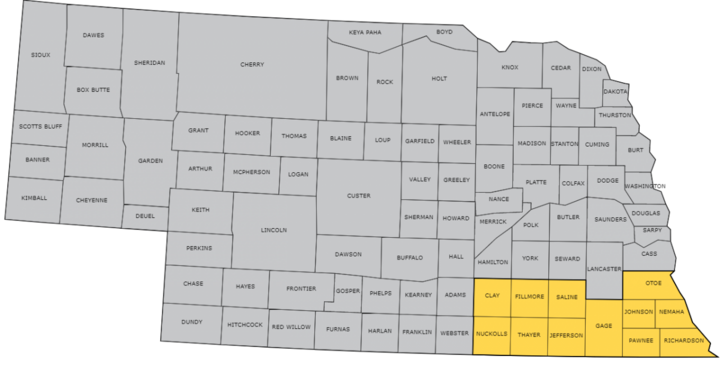Interest and concern about micronutrient needs of soybean is common among farmers and agronomists due to higher yields than in previous decades and the increased availability of micronutrient fertilizers in both liquid and dry formulations. Nathan Mueller’s interest in micronutrients goes back to his PhD research from 2009-2012 at Kansas State University that focused on starter and foliar applications of micronutrients in corn and soybean in eastern and north central Kansas. We are bringing you an extended series of CropWatch articles on micronutrient fertility and plant nutrition for soybean production in southeast Nebraska (Figure 1). In this article series, we will explore why each micronutrient is essential to soybeans, known deficiencies and toxicities in the southeast Nebraska and nearby regions, soybean specific micronutrient factors, factors of micronutrient availability in soil, soil and plant tissue testing, and fertilizer recommendations.

Micronutrients
Nine essential micronutrients are needed in small amounts by soybeans. Micronutrients include boron (B), chloride (Cl), cobalt (Co) copper (Cu), iron (Fe), manganese (Mn), molybdenum (Mo), nickel (Ni), and zinc (Zn). Nutrient uptake by soybeans for each of these nine micronutrients is usually less than one pound per acre other than for iron and chloride.
Issues Specific to Region and Crop
Potential micronutrient issues are regional in nature. For example, boron deficiency in soybeans following rice in Arkansas is not uncommon or copper deficiency in small grains on poorly drained peat and muck soils in the upper Midwest. Even within Nebraska, we see differences between crops, regions, and soils when it comes to micronutrients like iron deficiency chlorosis in soybeans (Figure 2). This series will focus on soybean micronutrient management in the Southeast Nebraska USDA Crop Reporting District (Figure 1).

Resources to Read
Feel free to read two Nebraska Extension publications called Nutrient Management for Agronomic Crops in Nebraska and Micronutrient Management in Nebraska. Second, look over a great regional publication called Micronutrients for Soybean Production in the North Central Region published in 2017 by five different universities. For those in this area of the state, stop by our Extension offices in Saline (Wilber), Jefferson (Fairbury), Gage (Beatrice), Clay (Clay Center) counties to get your free hard copy of the 2019 Edition of the Nebraska Soybean and Corn Pocket Guide produced in partnership between University of Nebraska-Lincoln Extension, Nebraska Corn Board, and the Nebraska Soybean Checkoff. There is a specific section on soil fertility and plant nutrition in the pocket guide that is a great resource to keep in the pickup or your back pocket when out in the field. We will be referencing these four publications along with other pertinent resources for each of micronutrients.
Invitation
Join us in reviewing what we know about boron for soybeans production in southeast Nebraska in the next issue of CropWatch. Share with us what micronutrients you are most concerned about on your farm for soybeans. Take this quick 2-question survey and we will share the results in the next article in this series.
Take the Micronutrient Survey